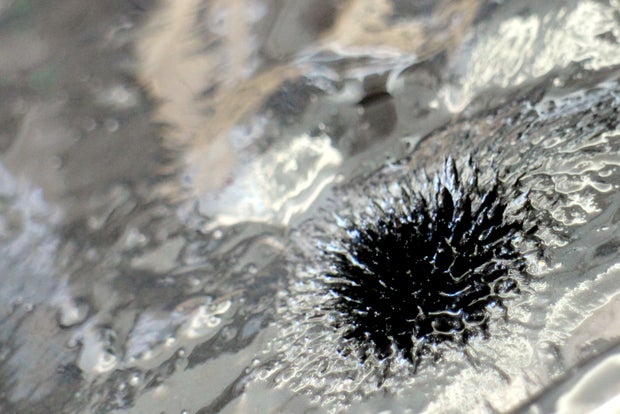Introduction: Ferromagnetic Fluid
Magnetic silly putty was pretty awesome, but it's time to take it to the next level with
Making your own ferromagnetic fluid (ferrofluid) is super easy, and it uses the same easy to get black iron oxide powder as the magnetic putty. The best thing about ferromagnetic fluid is that there's many ways to make it. Depending what medium you add to the oxide powder it will react differently; a low viscosity medium like water will allow you to play with magnetic fields with immediate feedback, a higher viscosity medium like mineral oil will suspend the oxide particles and create beautiful sculptures of magnetic fields. I'll show you how to make both.

Ready to get polarized? Let's make!
Step 1: Supplies
Since we're working with paint pigment you'll need to protect your work surface, and wear protective gloves so you don't stain your hands.
Step 2:
Add a small scoop of iron oxide powder to a clean and dry glass container. You won't need much, about one half scoop for a 6oz (175ml) container.
Fill remainder of container to the brim with water. Don't worry about any dry pockets of powder after the water is poured on top, the oxide powder will eventually be saturated with water.
Step 3: Seal With Caulking
Playing with ferromagnetic fluid is super fun, spilling it isn't.
To protect against eventual spills a bead of silicone caulking is added to the threads of the container and the lid tightly screwed on, creating a waterproof seal. The container was left upright to cure for a few hours.
Step 4: Add Magnet
After the caulking has cured you're ready to play with your container of ferromagnetic fluid. Bring a magnet close to the container and watch the magnetic field become visible as the iron filings attract in the water medium.
Try hovering the magnet at different distances away from the container to create different visual effects, or try dragging the magnet around the container and watch the filings pile up.
Step 5: Ferromagnetic Fluid With Oil
Another great medium to display a magnetic field is in a neutral oil. This type of ferromagnetic fluid makes a blob-like creation with similar properties for viewing the magnetic field.
Along with the black iron oxide you'll need mineral oil and a thin plastic dish to hold your liquid (I used a lid from a take out container).
Step 6: Add Oil and Mix
Scoop black iron oxide powder onto your dish and pour mineral oil over, stir until mixed completely and there are no lumps.
Step 7: Introduce Magnet
Place magnet underneath the dish and watch as the viscus ferromagnetic fluid takes the shape of the magnetic field.
Mesmerizing!

Have you made your own ferromagnetic fluid? I want to see it!
Happy making :)




